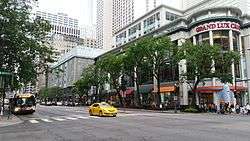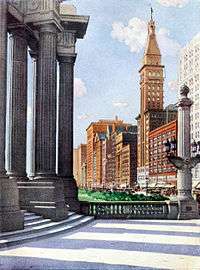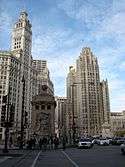Michigan Avenue (Chicago)
| 100 East | |
| Location | Chicago |
|---|---|
| South end | 127th Street |
| North end |
|

Michigan Avenue is a major north-south street in Chicago which runs at 100 east on the Chicago grid. The northern end of the street is at Lake Shore Drive on the shore of Lake Michigan in the Gold Coast Historic District. The street's southern terminus is at Sibley Boulevard in the southern suburb of Harvey, though like many Chicago streets it exists in several disjointed segments.[1]
As the home of the Chicago Water Tower, the Art Institute of Chicago, Millennium Park, and the high-end shopping on the Magnificent Mile, it is a street well known to Chicago natives as well as tourists to the city. Michigan Avenue also is the main commercial street of Streeterville. It includes all of the Historic Michigan Boulevard District and most of the Michigan–Wacker Historic District, including the scenic urban space anchored by the Michigan Avenue Bridge.
History

The oldest section of Michigan Avenue is the portion that currently borders Grant Park in the Chicago Loop section of the city. The name came from Lake Michigan, which until 1871 was immediately east of Michigan Avenue. The street at that time ran north to the Chicago river and south to the city limits. Originally, Michigan Avenue was primarily residential, and by the 1860s, large homes and expensive row houses dominated Michigan Avenue.
At no point is Michigan Avenue currently called Michigan Boulevard, but prior to the Great Chicago Fire of 1871, the street was officially known as Michigan Boulevard and often referred to as "Boul Mich".[2] But in the 1900-1907 Ads for the Chicago Musical College, the address was referred to as "202 Michigan Boul." As recently as the 1920s, North Michigan Avenue (especially the Magnificent Mile) was referred to as "Upper Boul Mich".[3] Paris's Boulevard Saint-Michel is the original Boul Mich.
.tiff.jpg)
In the Great Fire of 1871, all buildings on Michigan Avenue from Congress Street north to the river were destroyed. Immediately after the fire, the character of Michigan remained residential, but the street no longer was directly on the lake shore, as after the Fire, wreckage from the burnt district was used to fill in the inner harbor of Chicago, beginning the landfills that by the 1920s had moved the lake shore more than a quarter-mile east of its original shoreline, creating space for an expanded Grant Park. Beginning in the 1880s, the expansion of the central business district replaced houses on Michigan Avenue so that today, Michigan's character is primarily commercial north of 35th Street.
The first city showcase on Michigan Avenue was the Exposition Building, which was built on the current site of the Art Institute, the east side of Michigan at Adams, in 1874. By the 1890s, an imposing wall of buildings was constructed on the west side of Michigan Avenue downtown, including the Auditorium Building and the main branch of the Chicago Public Library (now the Chicago Cultural Center). As the east side of Michigan Avenue downtown was developed as a park, the wall of buildings lining the west side of Michigan Avenue across from the park became the nucleus of the city's skyline.
In 1924, the first traffic lights in Chicago were installed on Michigan Avenue after John D. Hertz fronted the city $34,000 for the purchase, installation, and maintenance.[4]

Route
North Michigan Avenue and the Magnificent Mile


Michigan Avenue originally ended at the Chicago River, and what is now Michigan Avenue north of the river was originally named Pine Street, after scattered pine trees originally found in its vicinity. As early as 1891 plans were proposed to extend Michigan Avenue north across the river.[5] An early plan called for a tunnel to link Michigan Avenue south of the river with Pine Street,[6] and in 1903 an editorial in the Chicago Tribune newspaper proposed a new Bascule bridge across the river at Michigan Avenue.[7][8]
This plan was further elaborated upon in Daniel Burnham's 1909 Plan of Chicago,[9] and in 1911 a plan was selected that included the widening of Michigan Avenue from Randolph Street to the river, replacing the Rush Street bridge with a new bridge at Michigan Avenue and the construction of a double-decked boulevard along Pine Street as far as Ohio Street.[10] When the Michigan Avenue bridge was completed, Pine Street was renamed Michigan Avenue. At its north end it merges into Lake Shore Drive near the Drake Hotel.
Today, the area north of the Chicago River is referred to as the Magnificent Mile, or sometimes simply the Mag Mile. It contains a mixture of upscale department stores, restaurants, high-end retailers, office buildings and hotels, and caters primarily to tourists and the affluent. The area also has a high concentration of the city's advertising agencies and major media firms, including the Chicago Tribune.
It is the home of Chicago's famous Water Tower landmark, Water Tower Park with its historic clock, as well as the eight-level Water Tower Place shopping center which grew up next door to, and overshadowed, the comparatively diminutive landmark. North of the shopping center can be found the famous John Hancock Center, the art deco Palmolive Building (also known as the Playboy Building) and the lavish Drake Hotel. The entire mile is noted for its spectacular Christmas displays. At the northern edge of this district can be found the One Magnificent Mile building; Chicago Landmark East Lake Shore Drive District, an extremely expensive and exclusive one-block area of real estate running east from North Michigan Avenue and facing directly onto Lake Michigan; and the on-ramp to northbound Lake Shore Drive.
From the River southwards



For a few blocks on both sides of the Chicago River, the road is double-decked, including the bridge over the river. The lower level north of the river is where the famous Billy Goat Tavern is located, and south of the river it intersects with Lower Wacker Drive. On the upper lever, tall office buildings and hotels line both sides of the Avenue, until Millennium Park.
The portion of Michigan Avenue opposite Grant Park is the Chicago Landmark Historic Michigan Boulevard District. Major cultural institutions, such as the Chicago Cultural Center, Symphony Center, and the Auditorium Theater are located here, as are many late 19th and early 20th century skyscrapers.
The Art Institute of Chicago is across the boulevard, in Grant Park along the Avenue. Several large historic hotels are located just south of Congress Parkway, including the Hilton Towers Chicago (formerly, the Stevens Hotel), the Congress Plaza Hotel and the Blackstone Hotel. Between them is the Spertus Institute of Jewish Studies.
The Avenue extends south into Near South Side, Chicago and beyond – past what was once the notorious Levee District, the graceful homes of the Prairie Avenue District, the historic Second Presbyterian Church, the former home of the legendary Chess Records at 2120 South Michigan and the site where the Lexington Hotel, a hideout of Al Capone, once stood.
South of Cermak Road is the Motor Row District, a historic strip along Michigan Avenue that was home to many early 20th century automobile "palaces." A point of interest in this area is the former Illinois Automobile Club, which later was used as the home of the Chicago Defender, a prominent African-American Chicago newspaper at 2400 South Michigan. A little bit further south is Bronzeville, a historic black community in Chicago. Points of interest include the historic Mercy Hospital and Medical Center, the Illinois College of Optometry and the South Side Community Art Center.
The intersection of Michigan Avenue and 35th Street is home to two important local institutions. On the northwest corner is De La Salle Institute, a Catholic high school which was attended by future Chicago mayors Richard J. Daley, Richard M. Daley, and Michael Bilandic. On the southwest corner is the Chicago Police Department Headquarters. Michigan Avenue continues through the South Side and dead ends at 63rd Street, just north of a rail yard and parking lots.
The Avenue continues heading south at 66th Street to Marquette Road, where it moves a half-block to the east back into alignment with the run north of 63rd Street. It then continues south to 89th Street where it dead ends once again for a housing subdivision and a railroad line. It resumes at 91st Street heading south through the working class Roseland community, featuring a large commercial strip along Michigan between 111th and 115th streets. The street dead ends again at 127th Street just before the Cal-Sag Channel. It begins again in the south suburb of Riverdale before finally terminating at Sibley Boulevard or IL RT-83.
Transportation
The CTA Red Line's Chicago and Grand stations are useful for reaching the Magnificent Mile. The Jackson station is close to the Art Institute, as are Loop stations on the Brown, Pink and Blue lines. Millennium and Van Buren Street Stations are located along Michigan Avenue serving the Metra Electric and South Shore Lines. The avenue is also traversed by a multitude of bus routes and taxi cabs primarily in the Downtown and Magnificent Mile areas.
See also
References
- ↑ Hayner, Don; McNamee, Tom (1988). Streetwise Chicago, Michigan Avenue/Michigan Avenue (Pvt.). Loyola University Press. p. 87. ISBN 0-8294-0597-6.
- ↑ "Boul Mich Tour". City of Chicago Department of Planning and Development, Landmarks Division. 2003. Retrieved 2007-05-31.
- ↑ Stamper, John M., "Chicago's North Michigan Avenue," University of Chicago Press, 1991, p. ix, ISBN 0-226-77085-0.
- ↑ "Golden opportunity". Chicago Tribune Magazine. 2007-11-25. p. 31
- ↑ ""I Will" Spirit Wins; Open Link Bridge Today". Chicago Tribune. May 14, 1920. p. 3.
- ↑ "Great Boulevard Subway Project for Connecting North and South Divisions of the City". Chicago Tribune. January 22, 1903. p. 3.
- ↑ "A Michigan Avenue Dream". Chicago Tribune. May 31, 1903. p. 16.
- ↑ "Experts Praise Boulevard Plan". Chicago Tribune. June 21, 1903. p. 8.
- ↑ Burnham, Daniel H.; Bennett, Edward H. (1909). Plan of Chicago. The Commercial Club of Chicago. pp. 101–107. Retrieved December 24, 2010.
- ↑ "Wide Boulevard Scheme Chosen". Chicago Tribune. July 11, 1911. p. 3.
External links
| Wikimedia Commons has media related to Michigan Avenue (Chicago). |
| ||||||||||
Coordinates: 41°53′48″N 87°37′27″W / 41.89669°N 87.62416°W